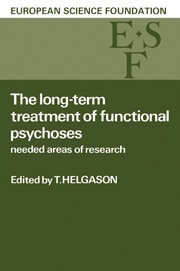Book contents
- Frontmatter
- Contents
- List of Participants
- Introduction
- I Organisational Aspects of Long-term Treatment
- Classification of functional psychoses requiring long-term treatment
- Structural changes in psychiatric hospitals
- Alternatives to hospitals: a field of promises and of not-yet answered questions
- The closing ofmental hospitals in Italy and its impact on long-term treatment of functional psychoses
- Future developments in Italy
- Optimal duration of long-term treatment in functional psychoses
- II Patients Aspects of Long-term Treatment
- III Public Health Aspectsof Long-term Treatment
- Index
Structural changes in psychiatric hospitals
from I - Organisational Aspects of Long-term Treatment
- Frontmatter
- Contents
- List of Participants
- Introduction
- I Organisational Aspects of Long-term Treatment
- Classification of functional psychoses requiring long-term treatment
- Structural changes in psychiatric hospitals
- Alternatives to hospitals: a field of promises and of not-yet answered questions
- The closing ofmental hospitals in Italy and its impact on long-term treatment of functional psychoses
- Future developments in Italy
- Optimal duration of long-term treatment in functional psychoses
- II Patients Aspects of Long-term Treatment
- III Public Health Aspectsof Long-term Treatment
- Index
Summary
Introduction
In this paper the national situation regarding psychiatric hospital services in Norway, developments during the last 30 years and the 1979 census are presented. Analysis of the Norwegian census throws light on the question of whether there will be a need for psychiatric hospitals in the future.
I will also discuss how psychiatric hospitals can be developed and modernized in their treatment procedures, and how such development is seen by patients and staff. Experiences of structural changes in two Norwegian psychiatric hospitals will be detailed; these point to needed areas of research in this field.
Psychiatric hospitals in Norway - a survey and a census
Great changes have taken place in the structure of psychiatric hospitals. As in most western nations, the ideology shaping mental care in Norway has shifted since World War II from a traditional institutional approach to a community-based concept of treatment for the chronic patient. There is a tendency towards deinstitutionalization. The author will give a report on the 1979 census of mental patients in Norway; this has recently been presented by Øgar (1983) and showed that about half of the mental hospital patients could be expected to remain there because adequate community facilities did not exist.
Until World War II, the 20 mental hospitals formed the cornerstone of care for the chronic mentally ill in Norway, a country of 4000000 inhabitants. Some government statistics illustrate the trend in mental hospital use since the War.
While there has been a reduction in the number of beds since 1964(Table 1), there has been a marked rise in the number of admissions, especially readmissions; this is an indication of more active treatment and rehabilitation efforts. This trend began even before the introduction of neuroleptics, as pointed out by Ødegård (1971).
The diagnostic distribution of patients has changed over the past 30 years. The annual number of first admissions for functional psychoses has been stable at approximately 1000. However, the number for senile and organic psychoses has nearly doubled over the last 20years, partly due to the increase in longevity. The number of patients suffering from drug or alcohol abuse has increased.
- Type
- Chapter
- Information
- The Long-Term Treatment of Functional PsychosesNeeded Areas of Research, pp. 15 - 24Publisher: Cambridge University PressPrint publication year: 1985

